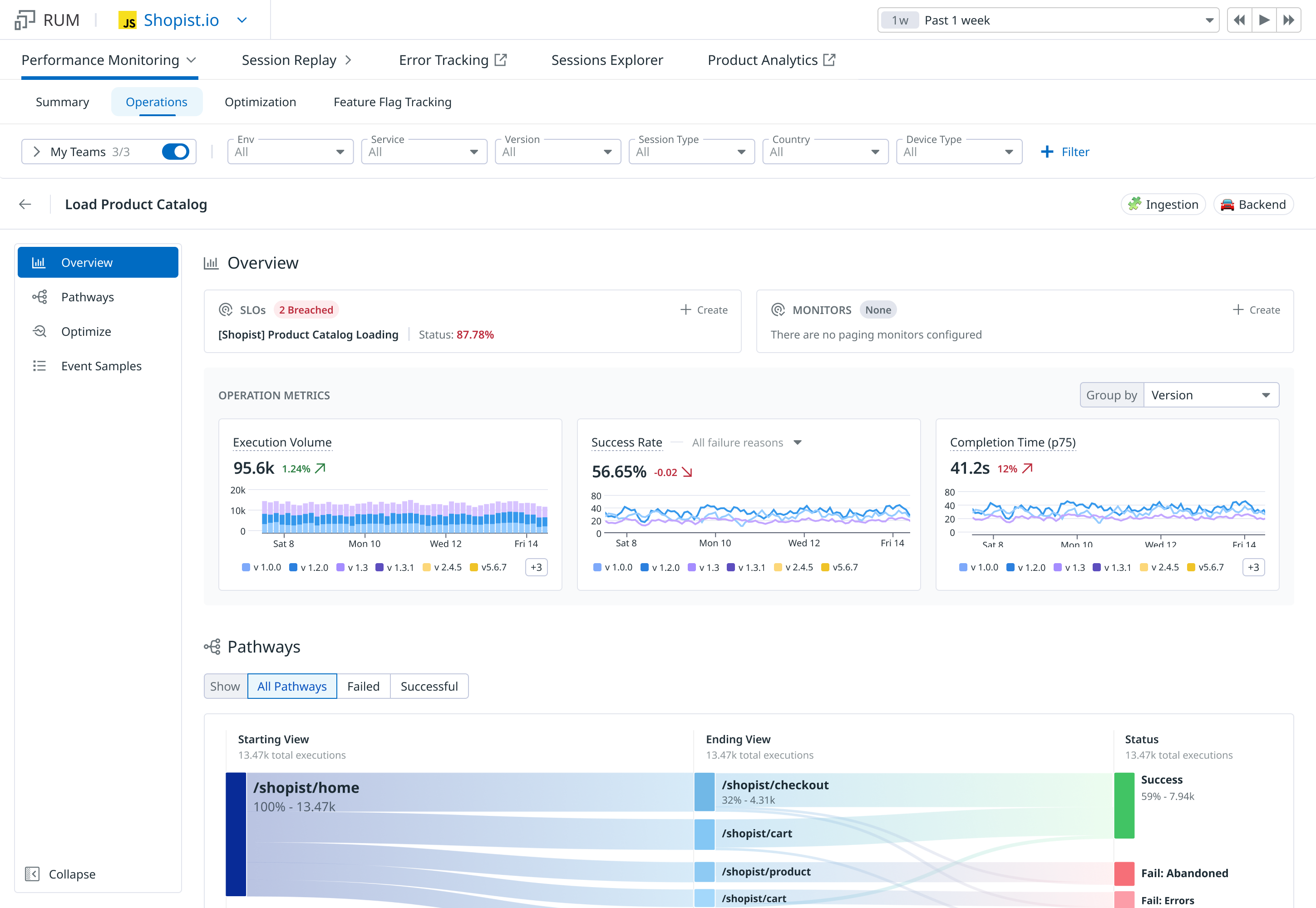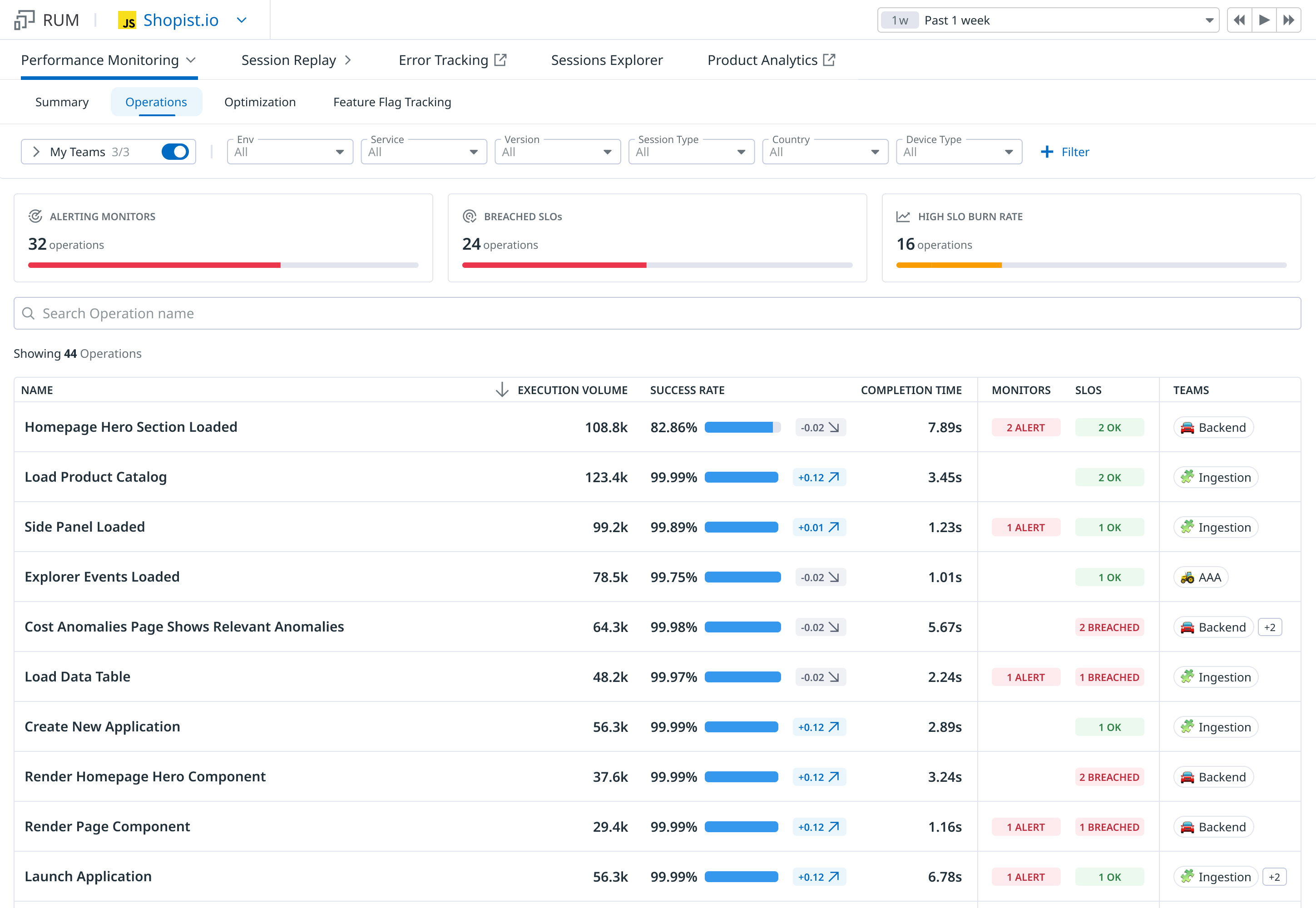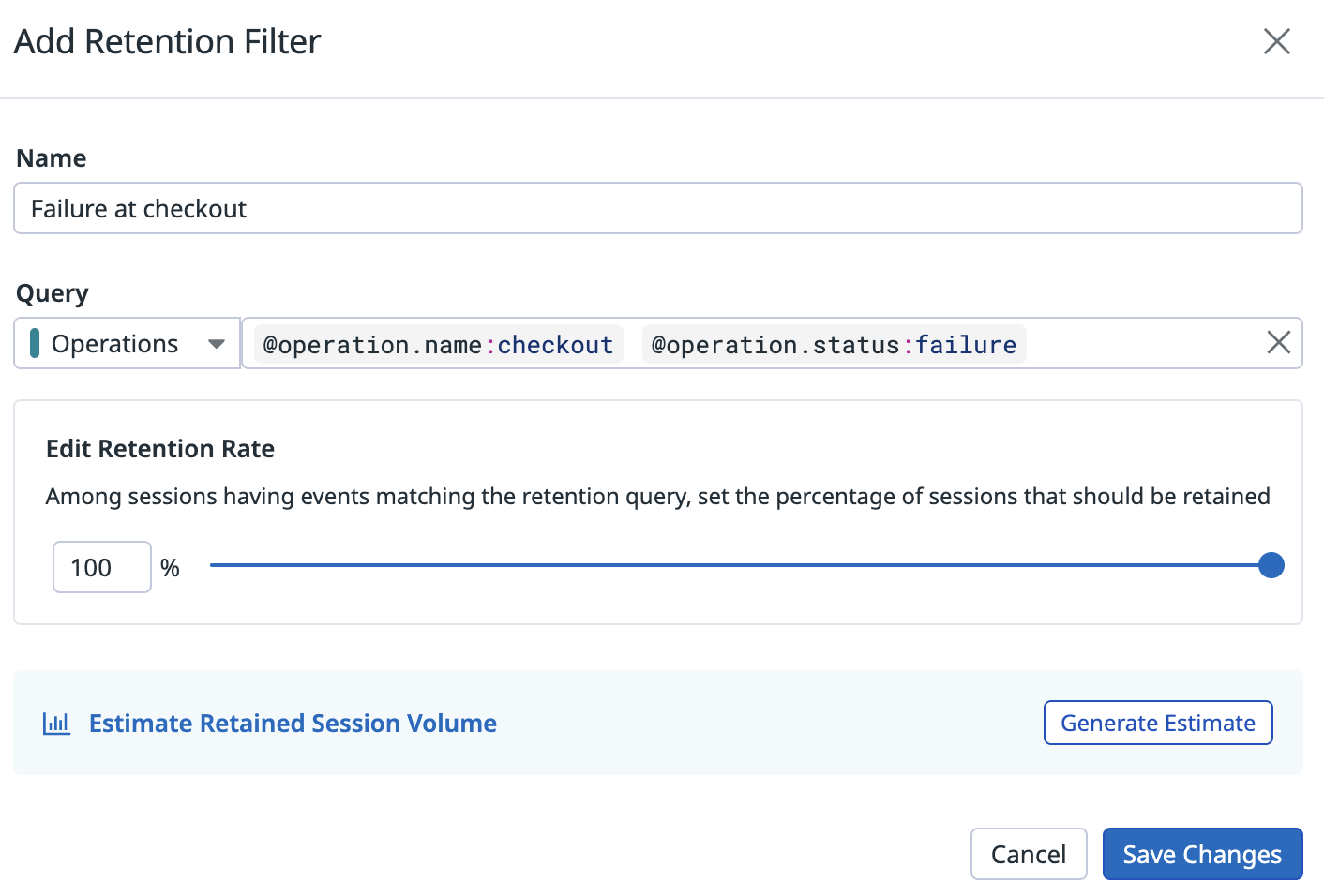- Esenciales
- Empezando
- Agent
- API
- Rastreo de APM
- Contenedores
- Dashboards
- Monitorización de bases de datos
- Datadog
- Sitio web de Datadog
- DevSecOps
- Gestión de incidencias
- Integraciones
- Internal Developer Portal
- Logs
- Monitores
- OpenTelemetry
- Generador de perfiles
- Session Replay
- Security
- Serverless para Lambda AWS
- Software Delivery
- Monitorización Synthetic
- Etiquetas (tags)
- Workflow Automation
- Centro de aprendizaje
- Compatibilidad
- Glosario
- Atributos estándar
- Guías
- Agent
- Arquitectura
- IoT
- Plataformas compatibles
- Recopilación de logs
- Configuración
- Automatización de flotas
- Solucionar problemas
- Detección de nombres de host en contenedores
- Modo de depuración
- Flare del Agent
- Estado del check del Agent
- Problemas de NTP
- Problemas de permisos
- Problemas de integraciones
- Problemas del sitio
- Problemas de Autodiscovery
- Problemas de contenedores de Windows
- Configuración del tiempo de ejecución del Agent
- Consumo elevado de memoria o CPU
- Guías
- Seguridad de datos
- Integraciones
- Desarrolladores
- Autorización
- DogStatsD
- Checks personalizados
- Integraciones
- Build an Integration with Datadog
- Crear una integración basada en el Agent
- Crear una integración API
- Crear un pipeline de logs
- Referencia de activos de integración
- Crear una oferta de mercado
- Crear un dashboard de integración
- Create a Monitor Template
- Crear una regla de detección Cloud SIEM
- Instalar la herramienta de desarrollo de integraciones del Agente
- Checks de servicio
- Complementos de IDE
- Comunidad
- Guías
- OpenTelemetry
- Administrator's Guide
- API
- Partners
- Aplicación móvil de Datadog
- DDSQL Reference
- CoScreen
- CoTerm
- Remote Configuration
- Cloudcraft
- En la aplicación
- Dashboards
- Notebooks
- Editor DDSQL
- Reference Tables
- Hojas
- Monitores y alertas
- Watchdog
- Métricas
- Bits AI
- Internal Developer Portal
- Error Tracking
- Explorador
- Estados de problemas
- Detección de regresión
- Suspected Causes
- Error Grouping
- Bits AI Dev Agent
- Monitores
- Issue Correlation
- Identificar confirmaciones sospechosas
- Auto Assign
- Issue Team Ownership
- Rastrear errores del navegador y móviles
- Rastrear errores de backend
- Manage Data Collection
- Solucionar problemas
- Guides
- Change Tracking
- Gestión de servicios
- Objetivos de nivel de servicio (SLOs)
- Gestión de incidentes
- De guardia
- Status Pages
- Gestión de eventos
- Gestión de casos
- Actions & Remediations
- Infraestructura
- Cloudcraft
- Catálogo de recursos
- Universal Service Monitoring
- Hosts
- Contenedores
- Processes
- Serverless
- Monitorización de red
- Cloud Cost
- Rendimiento de las aplicaciones
- APM
- Términos y conceptos de APM
- Instrumentación de aplicación
- Recopilación de métricas de APM
- Configuración de pipelines de trazas
- Correlacionar trazas (traces) y otros datos de telemetría
- Trace Explorer
- Recommendations
- Code Origin for Spans
- Observabilidad del servicio
- Endpoint Observability
- Instrumentación dinámica
- Live Debugger
- Error Tracking
- Seguridad de los datos
- Guías
- Solucionar problemas
- Límites de tasa del Agent
- Métricas de APM del Agent
- Uso de recursos del Agent
- Logs correlacionados
- Stacks tecnológicos de llamada en profundidad PHP 5
- Herramienta de diagnóstico de .NET
- Cuantificación de APM
- Go Compile-Time Instrumentation
- Logs de inicio del rastreador
- Logs de depuración del rastreador
- Errores de conexión
- Continuous Profiler
- Database Monitoring
- Gastos generales de integración del Agent
- Arquitecturas de configuración
- Configuración de Postgres
- Configuración de MySQL
- Configuración de SQL Server
- Configuración de Oracle
- Configuración de MongoDB
- Setting Up Amazon DocumentDB
- Conexión de DBM y trazas
- Datos recopilados
- Explorar hosts de bases de datos
- Explorar métricas de consultas
- Explorar ejemplos de consulta
- Exploring Database Schemas
- Exploring Recommendations
- Solucionar problemas
- Guías
- Data Streams Monitoring
- Data Jobs Monitoring
- Data Observability
- Experiencia digital
- Real User Monitoring
- Pruebas y monitorización de Synthetics
- Continuous Testing
- Análisis de productos
- Entrega de software
- CI Visibility
- CD Visibility
- Deployment Gates
- Test Visibility
- Configuración
- Network Settings
- Tests en contenedores
- Repositories
- Explorador
- Monitores
- Test Health
- Flaky Test Management
- Working with Flaky Tests
- Test Impact Analysis
- Flujos de trabajo de desarrolladores
- Cobertura de código
- Instrumentar tests de navegador con RUM
- Instrumentar tests de Swift con RUM
- Correlacionar logs y tests
- Guías
- Solucionar problemas
- Code Coverage
- Quality Gates
- Métricas de DORA
- Feature Flags
- Seguridad
- Información general de seguridad
- Cloud SIEM
- Code Security
- Cloud Security Management
- Application Security Management
- Workload Protection
- Sensitive Data Scanner
- Observabilidad de la IA
- Log Management
- Observability Pipelines
- Gestión de logs
- CloudPrem
- Administración
- Gestión de cuentas
- Seguridad de los datos
- Ayuda
Operations Monitoring
Esta página aún no está disponible en español. Estamos trabajando en su traducción.
Si tienes alguna pregunta o comentario sobre nuestro actual proyecto de traducción, no dudes en ponerte en contacto con nosotros.
Si tienes alguna pregunta o comentario sobre nuestro actual proyecto de traducción, no dudes en ponerte en contacto con nosotros.
Overview
In Datadog RUM, a feature represents a major user-facing area of your application like checkout, login, or search. Each feature includes operations, which are the critical technical steps that make the experience work.
- Business teams use features to track and improve user conversion.
- Engineering teams use operations to monitor and minimize technical failures that impact key user moments.
For example, the checkout experience of an e-commerce platform is a feature. Within it, operations might include entering payment details, saving a payment method, and completing a purchase. After the SDK has been instrumented, Datadog RUM measures each operation’s performance, including execution volume, completion rate, and failure rate. Measuring operations’ health enables you to identify exactly when and why users may not convert in your feature.
The following table shows additional example features and their associated feature operations by industry.
| Industry | Feature | Feature Operations |
|---|---|---|
| Social network | Profile | Users can load their profile Users can upload a picture Users can update their status |
| E-Commerce | Checkout | Users can enter payment details Users can save their payment method Users can pay |
| Streaming | Search | Users can find results for their search Users can load the description of a title Users can start watching the trailer |
| CRM | Quote | Users can start a new quote Users can add line items to the quote Users can send a quote to recipients |
Prerequisites
- RUM without Limits must be enabled in your organization.
- Make sure you’ve downloaded a supported Datadog RUM SDK version with client-side APIs to define operations:
Setup
Use the SDK APIs to define your operations.
Start an operation
Every operation must be started by calling the startFeatureOperation.
DD_RUM.init({
...,
enableExperimentalFeatures: ["feature_operation_vital"], // you need to have this flag turned on for the API to work
})
startFeatureOperation: (
name: string,
options?: {
operationKey?: string,
context?: Context,
description?: string,
}) => void
GlobalRumMonitor.get().startFeatureOperation(
name: String,
operationKey: String?,
attributes: Map<String, Any?>
)
RUMMonitor.shared().startFeatureOperation(
name: String,
operationKey: String?,
attributes: [AttributeKey: AttributeValue]?
)
Stop an operation with success
Every started operation must have a stop. Use succeedFeatureOperation to stop an operation with a successful outcome.
DD_RUM.init({
...,
enableExperimentalFeatures: ["feature_operation_vital"], // this flag needs to be enabled for the API to work
})
succeedFeatureOperation: (
name: string,
options?: {
operationKey?: string,
context?: Context,
description?: string,
}) => void
GlobalRumMonitor.get().succeedFeatureOperation(
name: String,
operationKey: String?,
attributes: Map<String, Any?>
)
RUMMonitor.shared().succeedFeatureOperation(
name: String,
operationKey: String?,
attributes: [AttributeKey: AttributeValue]?
)
Stop an operation with failure
Every started operation must have a stop. Use failFeatureOperation to stop an operation with a failure outcome.
DD_RUM.init({
...,
enableExperimentalFeatures: ["feature_operation_vital"], // this flag needs to be enabled for the API to work
})
GlobalRumMonitor.get().failFeatureOperation: (
name: string,
failureReason: FailureReason, //'error' | 'abandoned' | 'timeout'| 'other'
options?: {
operationKey?: string,
context?: Context,
description?: string,
}) => void
GlobalRumMonitor.get().failFeatureOperation(
name: String,
operationKey: String?,
reason: RUMFeatureOperationFailureReason, // .error, .abandoned, timeout, .other
attributes: Map<String, Any?>
)
RUMMonitor.shared().failFeatureOperation(
name: String,
operationKey: String?,
reason: RUMFeatureOperationFailureReason, // .error, .abandoned, .timeout, .other
attributes: [AttributeKey: AttributeValue]
)
Parallelization
You may have cases where users are starting several feature operations in parallel. To individually track them, use the operationKey defined when calling startFeatureOperation. You must reuse the same operationKey later in other APIs, for example when calling succeedFeatureOperation.
Operations that have been started but not explicitly stopped are automatically terminated when the RUM session expires. Those are marked as failed, with
If an operation stop API was called that was not started in the first place, the stop event emitted by the SDK is dropped upon ingestion.
@operation.failure_reason:timeout.If an operation stop API was called that was not started in the first place, the stop event emitted by the SDK is dropped upon ingestion.
Monitor your availability on Datadog
After you’ve configured the SDK APIs, you can monitor your operations by navigating to RUM > Performance Monitoring > Operations.
Datadog groups together all operations with the same name into a catalog.
Each operation has two out-of-the-box metrics computed over your full, ingested, unsampled traffic:
rum.measure.operation, which counts the volume of operations reported to Datadogrum.measure.operation.duration, which measures the elapsed time between the start and end of all the operations reported to Datadog
Both metrics are retained for 15 months, and include several dimensions:
operation.name, which is defined on the client sideoperation.status, which is either a success or failureoperation.failure_reason, which can be an error, or abandoned, or timeout, or other
Those metrics are included in the price of RUM Measure and available to all RUM without Limits customers that define one or more operations.
Configure retention filters
Operations are a new type of event in RUM. Operations are bound to a RUM Session, but can span across multiple RUM Views. Operations can be targeted in retention filters. This allows you to align your retention strategy on features that are cornerstones for your user experiences. For example, you can programmatically keep RUM Sessions that had specific operations fail or are taking longer than desired.
Similarly to metrics, those events come with specific attributes you can use in retention filters:
@operation.name@operation.status@operation.failure_reason@operation.duration@operation.start_view.name@operation.end_view.name
Further Reading
Más enlaces, artículos y documentación útiles:



